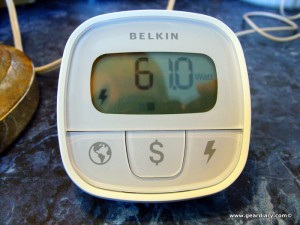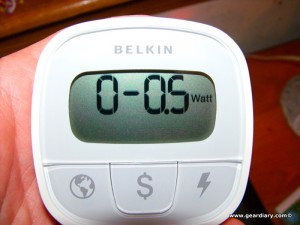With the economy in the state it is in we are trying to conserve what we spend anyway we can. Whether we are turning the thermostat down, turning off lights or buying compact fluorescent bulbs that use less electricity, we are all trying to save what we can on our electric bill. All of this got me wondering: how much power your laptop really uses? How about my TV? Do compact fluorescent bulbs really save any money over standard incandescent bulbs? With Belkin’s new Conserve Insight finding the answers was simple.
The device is simple and easy to use. All you have to do is plug it into the wall and then plug in the electricity-sucking device you want to measure. The LCD on the Conserve initially lights up when you plug it into the wall. When you turn the device being measured all sorts of interesting facts appear.
As a test, I plugged a lamp into the Insight and then tried both a 60 watt incandescent bulb and a compact fluorescent bulb. Let’s take a look at how each did.
Example of the test rig.
The first button on the right is the wattage button. As you can see, the rating on the bulb is really close to what it’s using.
The middle button shows you how much it will cost to power the bulb for one year. I have no idea what they base this estimate on as I could not find any information on the website or in the included documentation. So while I don’t trust the actual dollars it is good for comparing one bulb to the other.
The last button shows you how many pounds of CO2 that the device will contribute to the atmosphere for over a year. Again I could not find what they are basing this estimate on.?
Yes, the figures the device offers are merely estimates but it does offer some insight that can be useful, especially When trying to demonstrate to kids just how much it might cost to leave the lights turned on all night.
The comparison:
Above is the wattage display for a 60 watt equivalent compact fluorescent light bulb. The CFL or compact fluorescent uses significantly less power to produce the same amount of light as a standard incandescent light bulb.
So the CFL is a clear winner when it comes to actual energy use. It is not, however, a perfect exchange as the CFL brings its own issues with it. You see, the CFL uses mercury. That means, among other things, that if you break a CFL you must use different procedures to clean it up. Moreover, when a CFL has reached its end of life you need to dispose of it properly. So it uses less energy for sure but there are other issues to consider.
Oh, and here is one other test… And a bit of a shocker. I like to bake cookies. Here is the amount of energy my stand mixer uses when there isn’t even food in the bowl. 129 watts!!! That just seems like an awful lot to me. Good thing I don’t use my Kitchen Aid every day. 🙂
Conclusion
The Belkin Conserve Insight does exactly what its name implies. It gives you insight in to how much all of those things that use electricity might cost you. Remember the Conserve Valet I recently reviewed?? Well the Insight revealed that when the Valet is plugged in and not charging devices, it uses no power at all. I applaud Belkin for making devices that will help us save energy and see how much energy we’re using. The Conserve Insight has definitely helped me find out where I can shave a few bucks off of my electric bill if not for the month at least for the year and the more money I don’t have to send to the power company the better. The Conserve Insight is available at the Belkin website.
MSRP: $29.99 (Want it for less? Check out the affiliate link on New Gear Daily!)
What I liked: A useful tool for giving you insight on where you can save money on your electric bill.
What needs improvement: Belkin should tell you where it gets the figures for the costs as well as the CO2. These two buttons may not be accurate over time. Given the watts used that the Insight gives you and your current electric bill you can calculate the specific costs for you.































